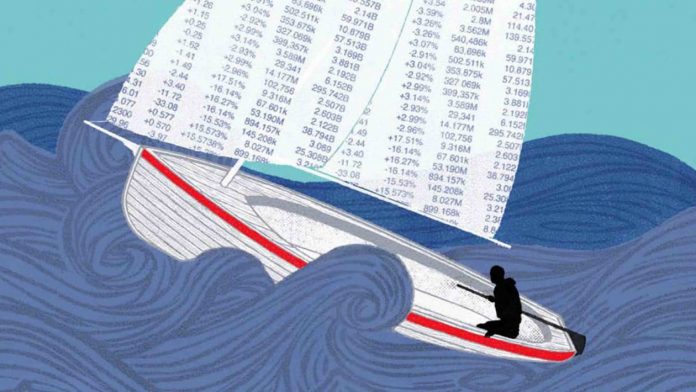Illustration by Jay Vollmar
Illustration by Jay Vollmar
Investors can be forgiven for feeling seasick. Since hitting record highs in late 2021 and earlier this year, major market indexes have been mostly sinking, with small-company stocks and tech shares faring the worst.
The market has endured waves of volatility as investors try to balance strong corporate fundamentals against the fear of monetary tightening as the Federal Reserve attempts to contain inflation.
From its high on Jan. 3, the S&P 500 fell 9.8% through Jan. 27 – technically, just shy of an official correction, considered a 10% drop. The broad market measure tripped the 10% mark intraday, however.
It's not clear whether the market has found a floor. History shows that corrections in volatile election years – as this one promises to be – are often steeper than 10%. But absent a recession, corrections tend to be good buying opportunities. However it plays out, the current unpleasantness is a reminder that stock market corrections are a fact of investing life.
The time between corrections of 10%-plus in the S&P 500 is 410 days, on average, according to investment research firm CFRA. As of Feb. 4, we'd gone 635 days without one.
Investors are adjusting to a new economic regime, with less monetary and fiscal stimulus. Economist Ethan Harris, at BofA Global Research, expects seven quarter-point hikes in the federal funds rate in 2022, and another four in 2023 as the Fed gets serious about inflation. "We sound like uber-hawks, but I don't think it's a radical call," he says.
The fear is that inflation could spiral out of control as price and wage increases feed off each other, exacerbated by geopolitical tensions that could send energy prices higher. "Inflation is the big issue, and oil prices within that," says market strategist Ed Yardeni, at Yardeni Research.
On the plus side for the economy and financial markets is a pile of cash on corporate and household balance sheets that has built up during the pandemic. According to BofA, U.S. consumers and corporations hold a record $19 trillion in cash, up 35% since 2019. "Call it saving for a sunny day," says Harris. "It's a big support for growth going forward."
Still, the base case for markets is for slowing economic growth, significant inflation and more-muted returns.
IHS Markit chief U.S. economist Joel Prakken recently lowered the firm's forecast for U.S. economic growth in 2022 from 4.1% to 3.7% (compared with 5.7% in 2021) and ratcheted up the forecast for the rate of inflation from 4.2% to 4.5% (compared with 7% at the end of 2021).
Yardeni lowered his call on the market from 5,200 for the S&P 500 by year-end to 4,800, going from expectations of just over a 9% gain to essentially flat. "Double-digit increases in the S&P are kaput – that's not going to happen anytime soon," he says. He now sees the S&P hitting the 5,200 level in the second half of 2023.
Since 1950, the 21 market corrections that have taken place without a recession have posted average declines of 15%, according to Goldman Sachs research. But corrections without recessions have tended to be good buying opportunities, even when you take the plunge before the trough.
Goldman is advising clients to focus on high-quality stocks – those with strong balance sheets, high profit margins and reasonable valuations. Companies Goldman says fit that rubric include health care firm Moderna (MRNA, $163) and oil and gas producer Coterra Energy (CTRA, $23). Fund investors might like Fidelity Quality Factor ETF (FQAL, $52) – a basket of high-quality companies.
BofA recommends overweighting the energy, financials and healthcare sectors in your portfolio. Look for stocks that represent value over those more focused on growth and for companies with robust free cash flow (cash profits left after investing to maintain and expand the business).
Don't overlook the bargains that rough days in the market present. Underperformers rated Buy by BofA include chipmaker Applied Materials (AMAT, $136), down 14% this year through Feb. 4, and homebuilder D.R. Horton (DHI, $84), down 23%.
Small- and mid-cap stocks look like bargains. The Russell 2000, a small-cap benchmark, is down 11% so far this year. Small stocks typically don't do well during Fed tightening cycles, but their prices may already reflect that, say BofA strategists. Two T. Rowe Price funds we like are Small-Cap Value (PRSVX), one of the Kiplinger 25, the list of our favorite funds, and Mid-Cap Growth (RPMGX), recently reopened to new investors.
Prepare for more volatility, says Katie Nixon, chief investment officer at Northern Trust Wealth Management. Companies that exceed profit expectations with the ability to pass on price increases are being richly rewarded; those that miss projections are punished severely.
Meta Platforms (FB) – the old Facebook – lost more than $230 billion in market value in one day following underwhelming earnings, the largest single-day drop in market value on record, according to Nixon. The next day, Amazon.com (AMZN) logged the largest one-day gain in market value: $191 billion, after its earnings report.
Reassess your portfolio to make sure assets are in line with long-term goals, that you have enough cash to fund near-term goals and that your assets reflect your risk tolerance, says Nixon. "Rebalancing portfolios will allow investors to look through this period of volatility and focus on the long term."
Kiplinger is part of Future plc, an international media group and leading digital publisher. Visit our corporate site www.futurenet.com
© Future US LLC, 10th floor, 1100 13th Street NW, Washington, DC 20005. All rights reserved.






